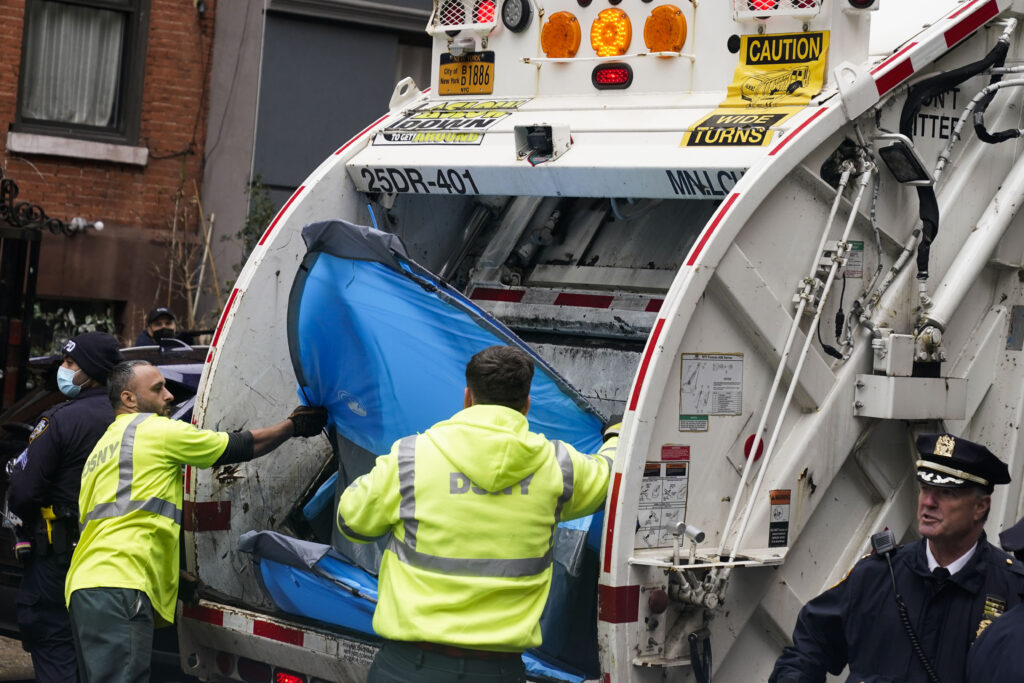
Sanitation and containerization are an easy policy area for New Yorkers to take for granted, but investing in it is crucial. Still, this seemingly simple policy area produces some of the city’s most drastic responses. New York has waged a War on Rats, appointed a Rat Czar, and deployed New York’s Strongest to lead a historically aggressive fasting diet for rats through containers. The city has considered containerization for decades, only recently making major strides in its implementation with a rules amendment for food businesses. This policy will bring about positive changes for the city in addressing the rodent problem, but NYC should demand shared stationary containers to coordinate private investment in the production of operative infrastructure if it wants to send rats packing.
Containerization entails the use of rigid, lidded containers to collect trash and food waste, replacing the traditional practice of bagged garbage left on the streets. The Department of Sanitation (DSNY) currently collects 24 million pounds of trash, recycling, and compostable material every day. Although that figure is unbelievably large and highlights NYC’s global leadership in producing waste, the pedestrian-obstructing piles of trash on sidewalks have long lent the public some perspective on the quantity of trash the city must address. The accumulation of waste in public spaces poses health risks, reveals disparities in service provision, and attracts pests. These pests can carry diseases and transmit them to humans. In New York City, trash sits in rat-clawable bags for hours, and sometimes days, in front of every property. Considering rats typically nest within 100 feet of consistent food sources, the necessity to contain odors and open food is evident.
Before the new rule, food businesses and residential buildings had to pack trash in secure, opaque black bags with a 55-gallon limit. The problems with this policy were apparent, as spillage and street conditions accounted for a large percentage of complaints issued to the sanitation department, and storefronts were blighted by mountains of black trash bags. At the end of June 2023, New York phased in a new rule that mandates that food-related businesses must use lidded containers for their trash and food waste. Considering that food businesses account for 20 percent of all businesses in the city, and these businesses produce a substantial amount of waste that attracts rats, the policy language has the clear objective of disrupting the rat food supply. At the beginning of September 2023, the rule expanded to cover chain businesses with five or more locations in the city, regardless of what they sell, slowly increasing the coverage to 25 percent of businesses. The implementation standards are clear: businesses must adhere to these containerization requirements to prevent both food waste and rats from proliferating. Within the month, the DSNY had given 22,000 warnings to businesses with a clear intention of issuing fines when ticketing came into effect on September 1, 2023. These fines coordinate an environment where mass-policy adherence is the utility-maximizing choice for food businesses, which will lead to more containerization and fewer rats.
However, the fines have become the subject of criticism, especially as DSNY ramps up its social media campaign to call out businesses that don’t obey the policy. Critics are worried about fines and DSNY’s strict program, fearing it burdens businesses and contractors. Implementing containerization may strain smaller enterprises financially. Doubts exist about the city’s smooth transition and comprehensive enforcement. These concerns underscore the need for a balanced approach, considering practical challenges and economic impacts on businesses while enhancing waste management practices.
Furthermore, while this food-business policy is undoubtedly a positive step forward, it’s crucial to recognize that the fight against rats extends beyond eateries and delis. Other avenues, such as residential areas and public spaces, are yet to be fully addressed in the ongoing battle against rodent infestations, but starting with containerization of food-business trash is a great market indicator in a sector experiencing a major market failure, a fact that critics are undervaluing. Half of all waste in NYC is carted by private companies, and the government relies on private manufacturers for its collection truck fleet. These private carters essentially aim to provide their trash services to clients as a more convenient and personalized service than the public operation, but their business relies on public sanitation inefficiencies, not on innovating collection methods. The lack of stated demand by cities for shared stationary containers has led to a limited supply of domestic manufacturers for these products, resulting in field workers having to unlock bins and manually load bags into standard rear-loader trucks. This causes collection delays, spillage, and great frustration for sanitation workers.
Germany invested in the research and development of efficient waste collection technology. They developed specialized waste collection trucks equipped with hydraulic systems for emptying stationary containers by publically investing in R&D and prioritizing domestic manufacturers. If North American cities with significant rat problems, like New York, coordinated in demanding these services with direct reference to previously implemented systems across the globe, domestic firms would be incentivized to invest in this scale of production and seek consulting in the tradable services market to do so. The implementation of this food-business rule is a great start and has proven that the private market will respond to support the implementation of the policy through the increased supply of secure bins. The city can continue its efforts through policies that provide a timeline for the increase of shared stationary containers and fleets equipped to pick them up.



